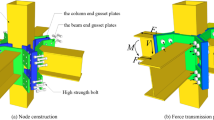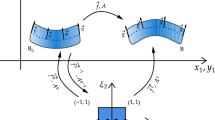Conclusions
-
1.
The intensity of compaction of a concrete mix and its permanent control are of decisive importance in obtaining firm and strong joints.
-
2.
With proper selection of the proportions of the concrete mix, preparation of the joint, and compaction of the placed concrete, all the possible technical methods (placing of the mix without an underlaying layer, placing on an underlying mix layer, and placing on a soft concrete layer) ensure the required strength and watertightness of the horizontal construction joints.
-
3.
When modem large vibrators are used, permanent control of the concreting and especially of the compaction of the concrete permit eliminating the underlying layer of mortar or soft concrete mix, with the result that the concreting operations are simplified and their cost lowered. This is especially important in the case of intense work on large structures.
-
4.
There are sufficient bases for revising Paragraph 217 of the “Technical Rules for Concreting Operations in the Construction of Hydraulic Structures,” in which the placing of an underlaying layer of mortar or plastic concrete is made mandatory. In such a revision, the technical procedures for concreting of the first lift of massive concrete blocks without underlying layers should be regulated. According to the preliminary estimates, this would yield an annual saving per each million m3 of concrete of 190,000 rubles and would result in a reduction in the labor use by 130,000 man-hours.
Similar content being viewed by others
Literature Cited
M. S. Khutoryanskii, Conditions for Monolithic Behavior of Plain and Reinforced-Concrete Structures [in Russian], GONTI, Moscow (1937).
A. N. Avakova, “Strength of concrete joints,” Stroitel'naya Promyshlennost', No. 7 (1937).
L. A. Igonin, “Proving-ground testing of the joining method of bonding concrete in horizontal joints of precast reinforced-concrete elements at the Saratov hydroelectric plant,” Gidrotekh. Stroitel'., No. 5 (1966).
A. A. Adamenkov and G. Ya. Alasyuk, “Strength of the contact joints of precast reinforced-concrete elements with concrete bonding layers,” Gidrotekh. Stroitel'., No. 8 (1966).
Ts. G. Ginzburg, “Laboratory tests on the watertightness and strength of block joints of concrete structures,” Izv. VNIIG,56 (1956).
S. I. Zubovich, “Preparation of contact surfaces for monolithic construction of precast reinforced-concrete structures with prefabricated members” Gidrotekh, Stroitel'., No. 6 (1969).
E. V. Lavrinovich, “Strength and stability of concrete joints and their relation to the types of cement and admixtures,” Gidrotekh. Stroitel. No. 7 (1957).
N. V. Mikhailov and M. B. Ur'ev, “Bonding of new to old concrete and joining of concretes in hydraulic construction,” Gidrotekh. Stroitel'., No. 9 (1961).
Yu. I. Pryshchenko and A. G. Goffman, “Strength and watertightness of concrete joints,” Gidrotekh. Stroitel'., No. 11 (1959).
P. A. Pshenitsyn, “Investigations of the strength of the contact zones between old and freshly placed concrete, and techniques for bonding precast concrete elements,” Trudy Gidroproekta, No. 11 (1964).
R. N. Shmantsar' and N. V. Shchelkunova, “Effect of methods of compacting concrete on the strength of the construction joints,” Énergeticheskoe Stroitel'stvo, No. 4 (1972).
L. A. Tolkachev and V. B. Sudakov, “Characteristics of horizontal construction joints at the Toktogul hydroelectric plant,” Gidrotekh Stroitel'., No. 11 (1973).
D. L. Houghton and D. I Hall, “Horizontal construction joints at Dworshak dam,” Journal of the American Concrete Institute,69, No. 3, 179 (1972).
E. V. Lovrinovich, A. A. Ravkin, and Yu. E. Mironov, “Investigation of the effect of the vibration intensity on the quality of horizontal construction joints,” Izv. VNIIG,101 (1973).
Additional information
Translated from Gidrotekhnicheskoe Stroitel'stvo, No. 9, pp. 9–11, September, 1974.
Rights and permissions
About this article
Cite this article
Ginzburg, T.G., Lavrinovich, E.V., Zinchenko, N.A. et al. Horizontal construction joints for massive high-head structures. Hydrotechnical Construction 8, 805–809 (1974). https://doi.org/10.1007/BF02380434
Issue Date:
DOI: https://doi.org/10.1007/BF02380434




